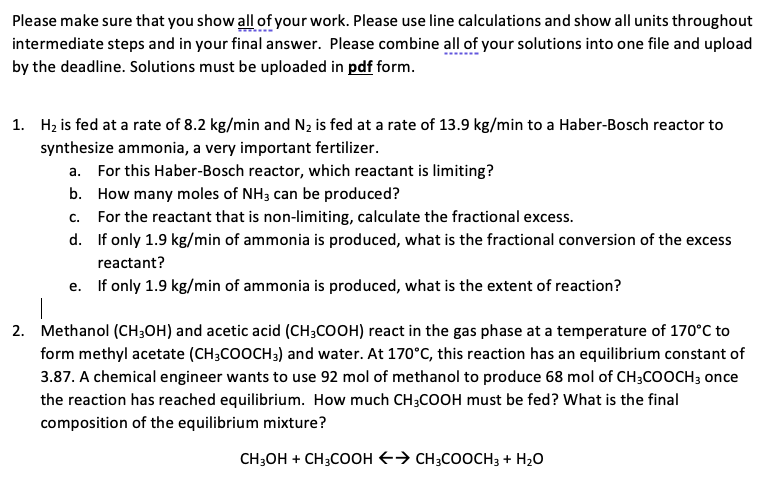1. H₂ is fed at a rate of 8.2 kg/min and N₂ is fed at a rate of 13.9 kg/min to a Haber-Bosch reactor to synthesize ammonia, a very important fertilizer. a. For this Haber-Bosch reactor, which reactant is limiting? b. How many moles of NH3 can be produced? C. For the reactant that is non-limiting, calculate the fractional excess.
1. H₂ is fed at a rate of 8.2 kg/min and N₂ is fed at a rate of 13.9 kg/min to a Haber-Bosch reactor to synthesize ammonia, a very important fertilizer. a. For this Haber-Bosch reactor, which reactant is limiting? b. How many moles of NH3 can be produced? C. For the reactant that is non-limiting, calculate the fractional excess.
Introduction to Chemical Engineering Thermodynamics
8th Edition
ISBN:9781259696527
Author:J.M. Smith Termodinamica en ingenieria quimica, Hendrick C Van Ness, Michael Abbott, Mark Swihart
Publisher:J.M. Smith Termodinamica en ingenieria quimica, Hendrick C Van Ness, Michael Abbott, Mark Swihart
Chapter1: Introduction
Section: Chapter Questions
Problem 1.1P
Related questions
Question

Transcribed Image Text:Please make sure that you show all of your work. Please use line calculations and show all units throughout
intermediate steps and in your final answer. Please combine all of your solutions into one file and upload
by the deadline. Solutions must be uploaded in pdf form.
1. H₂ is fed at a rate of 8.2 kg/min and N₂ is fed at a rate of 13.9 kg/min to a Haber-Bosch reactor to
synthesize ammonia, a very important fertilizer.
a. For this Haber-Bosch reactor, which reactant is limiting?
b.
How many moles of NH3 can be produced?
c. For the reactant that is non-limiting, calculate the fractional excess.
d.
If only 1.9 kg/min of ammonia is produced, what is the fractional conversion of the excess
reactant?
e. If only 1.9 kg/min of ammonia is produced, what is the extent of reaction?
T
2. Methanol (CH3OH) and acetic acid (CH3COOH) react in the gas phase at a temperature of 170°C to
form methyl acetate (CH3COOCH3) and water. At 170°C, this reaction has an equilibrium constant of
3.87. A chemical engineer wants to use 92 mol of methanol to produce 68 mol of CH3COOCH3 once
the reaction has reached equilibrium. How much CH3COOH must be fed? What is the final
composition of the equilibrium mixture?
CH3OH + CH3COOH → CH3COOCH3 + H₂O
Expert Solution
This question has been solved!
Explore an expertly crafted, step-by-step solution for a thorough understanding of key concepts.
Step by step
Solved in 2 steps

Recommended textbooks for you

Introduction to Chemical Engineering Thermodynami…
Chemical Engineering
ISBN:
9781259696527
Author:
J.M. Smith Termodinamica en ingenieria quimica, Hendrick C Van Ness, Michael Abbott, Mark Swihart
Publisher:
McGraw-Hill Education

Elementary Principles of Chemical Processes, Bind…
Chemical Engineering
ISBN:
9781118431221
Author:
Richard M. Felder, Ronald W. Rousseau, Lisa G. Bullard
Publisher:
WILEY

Elements of Chemical Reaction Engineering (5th Ed…
Chemical Engineering
ISBN:
9780133887518
Author:
H. Scott Fogler
Publisher:
Prentice Hall

Introduction to Chemical Engineering Thermodynami…
Chemical Engineering
ISBN:
9781259696527
Author:
J.M. Smith Termodinamica en ingenieria quimica, Hendrick C Van Ness, Michael Abbott, Mark Swihart
Publisher:
McGraw-Hill Education

Elementary Principles of Chemical Processes, Bind…
Chemical Engineering
ISBN:
9781118431221
Author:
Richard M. Felder, Ronald W. Rousseau, Lisa G. Bullard
Publisher:
WILEY

Elements of Chemical Reaction Engineering (5th Ed…
Chemical Engineering
ISBN:
9780133887518
Author:
H. Scott Fogler
Publisher:
Prentice Hall


Industrial Plastics: Theory and Applications
Chemical Engineering
ISBN:
9781285061238
Author:
Lokensgard, Erik
Publisher:
Delmar Cengage Learning

Unit Operations of Chemical Engineering
Chemical Engineering
ISBN:
9780072848236
Author:
Warren McCabe, Julian C. Smith, Peter Harriott
Publisher:
McGraw-Hill Companies, The